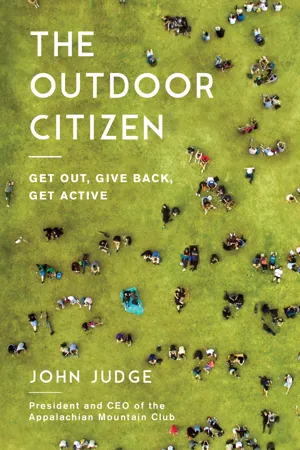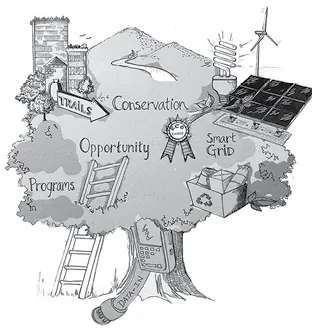![]()
Just as I’ve proposed the term “Outdoor Citizen,” I’d also like to pitch “Outdoor City” for your consideration. For me, an Outdoor City is a city rich with thriving green spaces easily accessible by all residents. It is forward thinking, with passionate Outdoor Citizen leaders championing the natural world in both the private and public sectors. It uses ever-increasing amounts of sustainable materials and practices, including a circular economy. It embraces technology to protect its natural assets, as well as local agriculture and environmentally friendly infrastructure and transportation, and it is abundant with outdoor recreation opportunities.
In 1933, the great French-Swiss architect Le Corbusier defined the keys to urban planning in his La Charte d’Athènes Paris (Charter of Athens). He wrote that “the four keys to urban planning are the four functions of the city: dwelling, work, recreation (use of leisure time), [and] transportation.” In today’s world, there is a fifth key: sustainability; it threads through each function and is a critical component of successful urban planning. A city’s sustainability refers to its ability to provide a high quality of life for its residents without causing environmental harm that will negatively affect the planet and the quality of life of future generations. A report from the World Commission on Environment and Economic Development, which has since become the Brundtland Commission, defines sustainable development by stating that it “seeks to meet the needs and aspirations of the present without compromising the ability to meet those of the future.”
Creating a sustainable city requires that residents actively advocate for green spaces, outdoor recreation, and eco-friendly infrastructure, materials, and practices, and that city planners, architects, engineers, real estate developers, investors, and public officials prioritize nature and outdoors spaces. All too often, today’s developers focus on maximizing indoor space and overlook how residents would benefit from outdoor space. In an Outdoor City, outdoor-focused strategies, plans, and programming would be core elements of urban planning, not afterthoughts, and proposed construction projects would need to receive an outdoor-centric sign-off from an authority to confirm that outdoor spaces were integrated into building plans and that the proposed infrastructure wouldn’t endanger existing outdoor spaces, before they would be allowed to go forward.
When I was the chief development officer for the city of Springfield, Massachusetts, a position I held from 2009 to 2011, I worked closely with city residents who knew the unique needs of their communities. We discussed ways to improve their neighborhoods—everything from adding green spaces to altering street layouts, fixing sidewalks to fostering economic development through urban renewal projects. We figured out how to best implement improvements, and I was able to help make those projects a reality by getting support from state government, and bringing together a team of designers, contractors, urban planners, and investors. The residents took an active role in improving their communities, and the collaboration was key to our success.
In my position as chief development officer, I had the privilege of working with Massachusetts State officials and the state’s commercial development entity, MassDevelopment, on an initiative called Gateway Cities. The program was designed to fund revitalization projects in cities that were struggling to find their economic footing. Most Gateway Cities were old mill and factory cities, legacy cities whose mills and factories had long since closed, and Springfield was one of them. During the American Revolution, the city was home to the Springfield Armory, which developed the first American musket and manufactured the Springfield rifles used during the Civil War. Later, it was home to the first assembly-line manufacturing, the mass production of vulcanized rubber, and key developments in the automobile industry, such as the United States’ first gasoline-powered car. But by the second half of the twentieth century, many of its manufacturing businesses had closed or moved elsewhere, and Springfield was in a state of decline.
With the support of the Gateway Cities program, we were able to renovate Springfield’s old federal building downtown, clean up a brownfield site (a formerly developed piece of land that had become vacant and possibly contaminated), and provide incentives for Springfield businesses to expand and others to relocate to Springfield. The city was one of fourteen Gateway Cities that existed during my time in office, and the program proved so successful that today there are twenty-six Gateway Cities in Massachusetts. The rejuvenation of Springfield and other Gateway Cities shows how city upgrades can be well implemented and how when community leaders and residents collaborate, they can positively transform even the most struggling cities.
Years before I worked with the city of Springfield, my friend Laurie Zapalac told me about legacy cities. Laurie has years of experience studying cities from an architectural and historic lens, and today has a PhD in Urban Planning from the Massachusetts Institute of Technology. We would take walks along green spaces, like Boston’s Charles River Esplanade, and she would explain to me how a city’s past can be preserved even while it upgrades and moves into a more prosperous and healthy future. Laurie spoke about US legacy cities as well as the historic cities of Europe, and her enthusiasm and faith in the promise of cities always shined through. Today she specializes in urban regeneration and helping communities thrive, and I recently asked her about best practices for this. I thought her response would be tied to technology as a way to modernize, but instead she said that cities do best when they embrace the natural world in ways that help them move forward. Laurie said, “Now, more than ever, we’re seeing that nature is the first and best teacher.” She said cities’ investments in the natural world have rippling benefits; for example, an investment in the restoration of shellfish populations can improve water quality, grow food, and promote economic development; an investment in parks can offer participatory and immersive experiences in the natural world and promote multigenerational interactions.
Laurie says the best practices often emphasize multipronged approaches, and that it’s necessary to consider them while keeping in mind “how people and their environment evolve over time.” This reflects the importance she puts on sustainability—how to meet today’s needs while keeping those of future generations in mind—and on how our cities and communities can approach planning and economic development with an eye toward a new model of sustainable engagement marked by enriching experiences, progress tracking, and personal accountability.
In 1634, America’s first city park, the Boston Common, was created. Today, the Boston Common (known locally as “the Common”) is enjoyed by millions of people each year. At each end is a subway stop to bring people from around the city to the Common and surrounding neighborhoods. Walking paths crisscross the fifty acres and connect pedestrians to concert venues, baseball diamonds, tennis courts, playgrounds, and a wading pond or ice-skating rink (depending on the season). I like to imagine that the natural parts of the Common haven’t changed much from when my grandparents enjoyed it in the 1920s, strolling through it or sitting on a bench under one of its trees to eat their lunch. I’m grateful to have enjoyed these experiences too, and I hope the park is maintained for future generations to do the same.
M...

